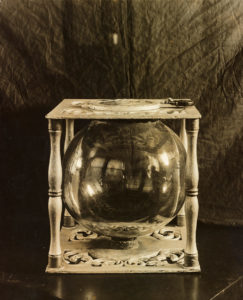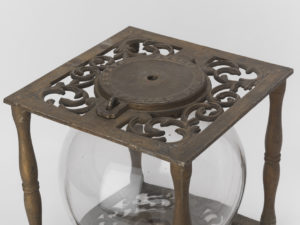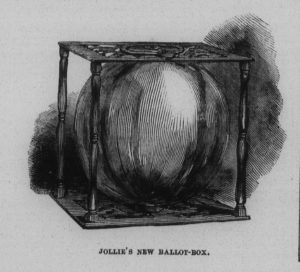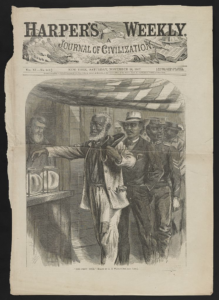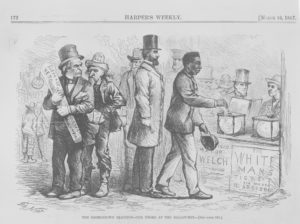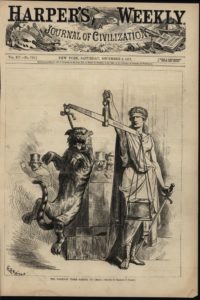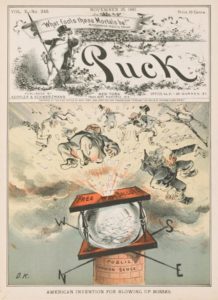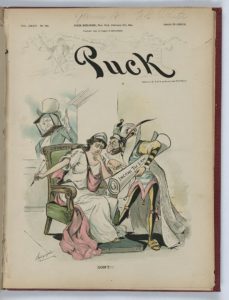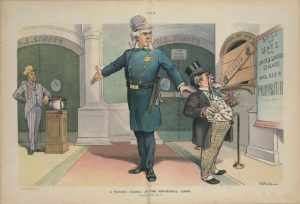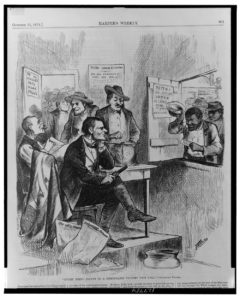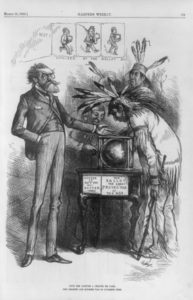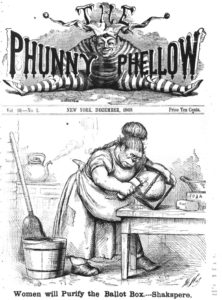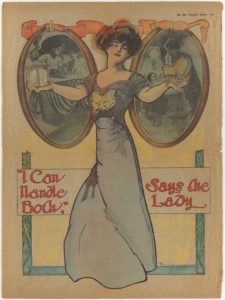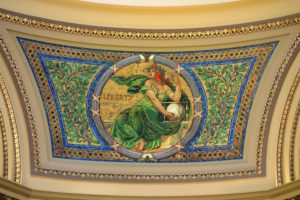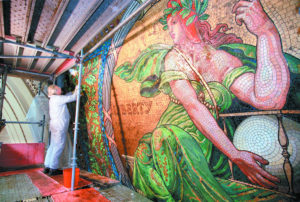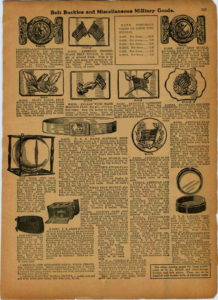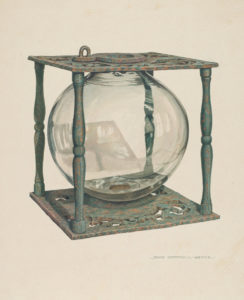In the summer of 1856, San Francisco was in turmoil. After allegations of corruption, criminal behavior, and election rigging, City Supervisor James P. Casey shot newspaper editor James King in cold blood. The city’s Committee of Vigilance, first formed in 1851 to fight corruption, reassembled, issuing their members medallions that featured an all-seeing eye and a personification of Justice who eschewed a blindfold, material reminders of their avowed commitment to observe, oversee, and perform their own “supervision” during this time of intensely perceived threats to democracy. In their ensuing investigations, members discovered concrete evidence of election fraud: the so-called “stuffer’s ballot box,” outfitted with a false bottom and side panel to conceal pre-marked ballots for the desired candidate (fig. 1). In response to this corrupt concealment, vision, visuality, and visibility became key concepts in maintaining and protecting a democratic society. This essay will explore the rhetorics of visibility and transparency that made themselves manifest in material form: a glass ballot box, designed, patented, and manufactured in New York in 1856-1857 and later illustrated in dozens of political cartoons and allegorical representations of the democratic process in the late nineteenth and early twentieth centuries. As much as the stuffer’s ballot box encapsulated fears and concerns about fraud and electoral rigging, the glass ballot box embodied both aspirations and anxieties.
Beyond San Francisco, several national newspapers ran the story of the deceptive ballot box, fearing it might be in use in their own districts. Frank Leslie’s included illustrations of the device, revealing its concealed panels and explaining its operations to readers:
The box is … a dark sky-blue color … The lock, which looked like an ordinary one, is so constructed that though it is worked with a key, it might also be opened by a peculiar pressure upon one side of the lid … On looking at the ballot box, few would suspect the contrivances about it; but on further and minute examination it was found that it had a false bottom and a false side, sliding in grooves under and behind which were packed quantities of spurious votes all ready for an election.
The deceptively plain blue box, which upon first appearance seemed so ordinary, was thus a device of concealment and chicanery. The newspaper’s accompanying illustrations also emphasized the simple, sturdy exterior, juxtaposed with cross-sections indicating the false panels and hidden compartments that obscured hidden ballots from inspectors’ view. How could faith in the ballot box be restored?
Meanwhile in New York, the State Assembly’s Committee on Grievances, also concerned about the possibility of ballot-box stuffing, “contrivances,” and the like, was charged with taking measures to prevent frauds at elections and to ensure “the purity of the ballot box.” As they proclaimed, the ballot box
… still fails to be a true reflection of the will of the people. …[I]ts guardians so far from protecting it, became the medium of its corruption and made its results such as they might desire … putting in unathorized ballots enough of an opposite character to outweigh and smother those honestly deposited. … [We] have but one desire and that is, an honest expression of the will of the people through the ballot box. … Underlying as does the ballot the beautiful superstructure of Republican institutions, it behooves all interested in their perpetuity or advancement to guard with especial vigilance its purity. The liberty of the subject, his property and reputation, all depend upon an honest election. … Cannot something be done to remedy this evil that is fraught with so much danger? Must we look coolly on and see the foundations of our liberty sapped, our glory depart, and our beautiful structure of self-government crumble and decay, the ballot dishonored, the elective franchise destroyed?
These concerns about “corruption” and “purity,” “evil,” “danger,” “honesty,” and “dishonor” indicate the gravity of the situation the legislators faced, with the very future of the democratic republic at stake. Indeed, what was to be done?
A Clear Alternative: The Glass Ballot Box
A few days after Frank Leslie’s published its account, New Yorker Samuel C. Jollie presented himself at the mayor’s office, unveiling his proposed solution with a flourish: a ballot box made of glass (fig. 2). In design and concept, it was the antithesis to the stuffer’s ballot box. Where the San Francisco box was wooden, dense, and plain, hiding its contents from view, Jollie’s invention offered viewers a transparent glass globe hovering in an architectural armature of iron columns, proudly exhibiting its gleaming, crystalline interior. Its hollow sphere seems to float within its setting. Its form was breathtakingly symmetrical, suggesting Leonardo’s “Vitruvian Man” with its suspension of a sphere inside a cube, its columns gently swelling toward the center and back out again like a baluster, or perhaps like the legs of a Windsor chair, which had supported delegates as they debated and drafted the Declaration of Independence and the Constitution in Philadelphia’s Independence Hall. Openwork designs on its top and bottom suggest acanthus leaves, lightening its cast iron density and allowing patterns of light to play upon the curved glass surface while also evoking classical ornament (fig. 3); seen from above, this metal plate looks like nothing so much as a cast iron heating grate (and indeed, several New York iron works of this period proudly advertised their decorative grates, done in the latest designs and amenable to custom orders). At the center of the metal top is a hinged circle or lid. “JOLLIE” curves around the top of this circle, underneath the hinge; “PATENT APPLIED FOR” curves around the bottom, above a tab with an opening that fits over a small metal loop that would accommodate a lock. At the very center, like a bulls’-eye, is a circular opening that could admit ballots, smaller than a dime but slightly larger than the diameter of a pencil, suggesting that the ballots would have to be tightly rolled, like a cigarette. Overall, the form suggests one half of an hourglass, its single globe displaying the votes that had been cast, rather than grains of sand indicating the progression of time, balanced delicately between the solid columns of its stand.
Jollie’s spherical box arrived on the scene at a crucial moment of fears about corruption, deception, and election tampering, when many Americans feared for the very future of their democratic society. While the outcries about political machines such as Boss Tweed and his Tammany allies were rampant, the late 1850s were also a hotbed of broader cultural concerns about visuality, deception, and fraud, as seen in the public fascination with P.T. Barnum and his “humbug” exhibitions and displays (incisively analyzed in Michael Leja’s Looking Askance: Skepticism and American Art from Eakins to Duchamp and James Cook’s Arts of Deception: Playing with Fraud in the Age of Barnum). Jollie’s transparent box is a striking material object that testifies to these perceived threats to honesty and democracy. The distinctive form of Jollie’s box made it a recognizable emblem of these fears and hopes for American democratic society, and it was invoked to support a variety of positions and claims, alternately advocating for or mocking potential voters and revealing concerns about the electoral franchise. The very medium of glass is a potent material for thinking through issues of transparency, malleability, and perceived fragility or strength, as these qualities were widely associated with the material properties of glass, popularly discussed in journals and advertisements.
The mid-nineteenth century saw an exponential growth in the prevalence and use of glass and, as Isobel Armstrong termed it in her exploration of glass in British literature and culture, a proliferation of “glass culture” or “Victorian glassworlds.” Manufacturing and purchasing prices for glass dropped radically in the mid-nineteenth century, and so the use of glass, from plate glass windows to home aquariums to London’s “Crystal Palace” for the 1851 World’s Fair, rose in a similarly dramatic fashion. Jollie’s design for a glass globe ballot box fits into this broader context of the abundance of glass.

Jollie explained his design and its construction in a patent application that extolled what he saw as the merits of his box, repeatedly emphasizing the importance of display, witnessing, sight, and visibility. These breathless passages suggest the assurances of a prestidigitator, encouraging audiences to watch him carefully during a sleight-of-hand trick:
The object of my invention is the production of a ballot box which shall at all times exhibit the condition of the ballotings, in other words a ballot box so constructed that the bystanders may see every ballot which is put in, see all the ballots that are in, and see them when taken out. And to this end the nature of my invention for this purpose, consists in the employment of a glass globe mounted in a frame, by which it is held in position, as to exhibit freely all that it contains, and with a hole at the top of sufficient size to admit the hand, and provided with a hinged cover having a hole of the required size to receive the ballots.
… In this way it will be obvious that the bystanders can see whether every ballot that is put into the hole actually goes into the box, and whether more ballots go into the box than are actually put through the ballot hole at top. The whole progress of the balloting is clearly in view, and when the ballots are taken out to be counted it must all be done in open view.
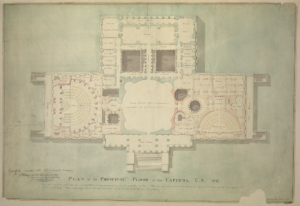
The “free exhibition” and “open view” of ballots, rather than their secrecy, was primary to Jollie, once again evoking the “all-seeing” rhetoric of the Vigilance Committee. While he did not claim all glass to be used in ballot boxes for his patent, he did wish to emphasize the use of the glass “globe,” a sphere of influence that would hover in its metal frame “without concealing the contents,” making the submission of ballots and fairness of elections self-evident to observers. Of course, the glass globe was not a true globe but instead a sphere that tapered to cylindrical openings at each end in order to be mounted in the metal frame; the top has a wider mouth almost like a fishbowl, wide enough, as Jollie indicates, for a hand to reach in and retrieve all the ballots that had been carefully deposited inside once the hinged lid is unlocked and opened. Examples of surviving bowls have strips of felt or ribbon encircling where the glass and metal meet, holding them in place. Despite their seemingly documentary style, the patent application drawings are somewhat unrealistic, showing the sides of the glass globe swelling beyond the constraints of the column in ways that it couldn’t possibly fit (fig. 4). The drawings nonetheless emphasize Jollie’s artistic aspirations for the project, his “Fig. 3: horizontal section” suggesting the architectural plans of a grand Neoclassical temple, its square dimensions supported by four columns and surmounted by a dome—a design which echoes, in fact, Benjamin Latrobe’s plans for the rotunda of the U.S. Capitol (fig. 5), itself inspired by the grand architecture of the Classical past, with all its invocations of democratic ideals and republicanism. The box could be read as a microcosm of these values, an evocation of representative government, assembled to enact the will of the people, an assembly chamber of votes joining together in anticipation of their elected politicians’ move to the House of Representatives.
The New York Times described it as a “transparent ballot-box … a hollow glass globe supported on four pillars. On the top of the globe is an aperture (large enough to admit a ballot) made in a brass lid fastened with a lock to the globe. The arrangement enables every vote to be seen as deposited, and prevents the possibility of false bottoms.” Their description thus noted both the architectural qualities of the box (referring to its “pillars,” possibly also evoking principles or ideals) and its key design of transparency, of allowing the observation of votes as they were submitted, preventing the subterfuge of hidden recesses and pre-filled ballots. There could be nothing “false” about this box. By exposing the inner recesses of the box through the use of a transparent medium and allowing all to see its contents, writers believed, the election would be secure. News of the invention was picked up as far as Baton Rouge, where Jollie was heralded as a “genius” whose invention “meet[s] the exigencies of the times, and [will] prevent fraud.” An example of the box was also displayed at S. G. Courtenay’s book shop in Charleston, South Carolina, as evidence of the measures to which New Yorkers had to go to “preserv[e] the purity of elections.”
Jollie’s example and description were referred to the Committee on Arts and Sciences of the New York Board of Councilmen, who enthusiastically embraced the design after their examination. As they reported at a meeting on September 15, 1856, the box “is of glass… strongly encased in an iron frame, and would prevent fraud, while it is impervious to even extraordinary force. It could be secured to the table of the inspectors of election by screws, and only removable at the close of the poll, and then by their direction, and under their supervision.” Explicitly contrasting Jollie’s invention with the infamous stuffers’ ballot box, they pointed to the merits of his construction: “It has … been shown that wooden boxes are liable to have false interiors, capable of stuffing illegal ballots, and that the wire boxes are insecure; but we believe that the glass cylinder in an iron frame, which would be proof against a pistol ball and capable of being secured to the table, would afford every desirable quality of publicity, perfect security, and inviolability to fraud.” The committee was at pains to assuage fears about the box’s potential fragility (literal or metaphorical), confident that it could withstand bullets or other attacks, and its openwork, acanthus-leaf adorned base could easily be secured to any surface to prevent its removal. The very transparency of the glass globe and visibility of the operations within would, they asserted, provide “perfect security and inviolability.” The committee recommended that the city invest in the boxes before the next presidential election.
State legislators were apparently intrigued by Jollie’s invention, and members of the committee appointed to prevent election fraud promoted the virtues of the glass box even more ardently. As their report proclaimed,
Your committee congratulate the country and themselves in being able to present for your consideration what they think to be a perfect remedy for the evils complained of, in the adoption of the transparent ballot box, invented by Samuel C. Jollie, made of glass so thick and substantial as to be as safe as the wooden box now used, and render it entirely impossible that any fraud should be perpetrated, either by the inspector or any one else in any of the ways now practiced by false bottoms in the box, or by putting in more than one ballot at a time, or putting in more votes after the ballot is closed. Assuming that the box is kept in sight of the electors, the ballot is in sight from the time it leaves your hand until it rests securely in the glass globe beyond the reach of any one, till the canvasser unlocks his charge and its truthful story by an honest canvass becomes recorded as the judgment of a free people.
In contrast with the dark murkiness of the wooden ballot box whose potentially hidden crevasses might contain contaminating and “false” votes, Jollie’s contraption provided literal transparency, keeping the ballots at all times “in sight” of voters and electors, as the committee repeatedly emphasized, suggesting a holdover from Enlightenment-era values that conflated visibility and virtue, what Michael Gaudio and Jay Fliegelman have referred to as the “politics of visibility” and self-evidence. Like Jeremy Bentham’s panopticon or the all-seeing eye of the Vigilance Committee medal, vision and visibility held the promise of eliminating corruption and ensuring virtuous, democratic behavior. Other articles similarly praised the transparent properties of glass and its perceived benefits for the electoral process; the New York Times suggested Jollie’s box would “permit the daylight to shine upon the mysteries of the elective franchise in New-York City,” thwarting those who might try to defile it. As the Times related, “It is said that one of the City fathers, on seeing the article, remarked that ‘it was a temptation to smash’”—here was a foil to his machinations and desired manipulations of the ballot box.
These descriptions also suggest the embedded violence that uneasily surrounded discussions of voting. When the state legislators described the process of voting as one in which “the canvasser unlocks his charge,” it is likely that they meant to describe a paternalistic arrangement of responsibility, of the canvasser keeping track of the votes of the citizens as though they were orphans under his care, or as a congregation under the guidance of a minister. Yet “charge” can also suggest an explosive quantity of gunpowder, a military action, or even an electrical shock, one that might have been sparked within the glass sphere of a Leyden jar. The glass ballot box contained many of these multivalent possibilities, evoking the volatility and stakes of the electoral process.
Despite common associations of glass and fragility or concerns about those who might try to “smash” the box, Frank Leslie’s assured readers, “its strength is even greater than the old box, and its contents are perfectly visible to any of the voters, thus rendering the purity of the election a matter of the most perfect certainty.” In their accompanying illustration, however, Jollie’s box emerges from a dark haze, its much-avowed transparency replaced instead by shadowy and distorted reflections of its armature box or of the dark room in which it sits (fig. 6). Despite the ominous rendering of the box, which here appears more like a mysterious crystal ball or hourglass, Frank Leslie’s was certain that employing Jollie’s invention nationwide would make the U.S. elections an example of “the purest Freedom has ever held.”
These repeated invocations of purity not only suggest ethereal values of virtue, but also the material properties of glass itself, as it was understood in the period. The nineteenth century saw a massive increase of chemical apparatuses and glassware, as Catherine Jackson and others have observed, and discussions of both scientific and decorative glass repeatedly emphasized the “purity” and non-reactivity of the medium. Clear, transparent glass was prized for looking as pure as water, capable of withstanding corrosive chemicals, not altering or reacting with contents. Though made from base materials like sand and ash, the high temperature at which glass formed was understood to eliminate impurities; as the entry on “glass” from the 1852 edition of Appleton’s Dictionary of Machines and Mechanics explained, “it is left to the process of melting to eject the impurities in a more or less complete manner.” In its non-reactivity, chemical glassware both allowed observation of the experiments unfolding within, while it also promised not to alter or interfere in chemical reactions. It thus is a remarkably neutral material, not merely a transparent one, and the potential associations of (political) neutrality and stability might also have resonated with viewers encountering the box, its central sphere resembling a round-bottomed flask.
Making the Sphere: Glass, Labor, and the Cost of Democracy
Glassware in this period, from decorative decanters and everyday drinking glasses to chemistry apparatuses and our ballot box, was widely understood to be formed by glass blowing. Surviving boxes suggest this too, with tiny air bubbles, irregular striations, and slight variations in their surfaces. In her wide-ranging consideration of nineteenth-century “glass cultures,” Isobel Armstrong has elucidated not only the pervasiveness of glass and its metaphors or “poetics,” but also the period’s awareness of the materiality and labor of glass, popularized by accounts of visits to glass factories, part of the genre of factory tourism. The work of glass-blowers was seen as a kind of alchemical magic, but also one that demanded skill and endurance, cooperation and coordination, all conducted under dramatic and demanding labor conditions: extreme heat, likelihood of injury, strength of muscle and lungs. Indeed, the hollow spheres of ballot boxes and wine goblets alike were formed from the breath of laborers. Although tabletop apparatuses and delicate items like test tubes could be made at home by chemists experimenting with glassblowing, the scale of Jollie’s glass globe would have required heavy industrial labor. One newspaper account from 1858 suggested that at least three firms contributed glass globes for the city’s large order: New England Glass Company and Bay State Glass Company, of Cambridge, Massachusetts, and the P.C. Dummer Glass Company, from nearby Jersey City.
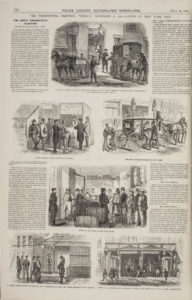
To make the globe of Jollie’s ballot box, glass workers would dip a long metal blowpipe into liquid, molten glass from a furnace maintained around 2,000 degrees Fahrenheit (this video shows of the process of glass-blowing, although the sphere for Jollie’s ballot box would have been approximately three times this size). Collecting molten glass on the end of the pipe in a glob known as a “gather,” an action that is often compared to the gesture of spooning up honey onto a dipper, the glass worker continually swirls the pipe in a circular motion to keep the glass on the end of his pipe with its centrifugal force. He (industrial glassworkers were almost always male in this period) then either rolls the end of the pipe with the hot glass gather across a slab (usually called a marver), so that this even force produces a round even shape and slightly cools the glass, or he molds it with a curved wooden scoop (called a block) that has been soaked in a bucket of water. Once the surface has cooled a bit, he brings the hollow end of the pipe to his mouth and blows, forming a bubble at the opposite end. To make the globe bigger or thicker, he could again return to the furnace to add more molten glass, continuing to roll the pipe and then blow into the tube. Once this reaches the desired size, the glass worker returns to a bench where he continues to roll the pipe, using gravity to help form an even sphere. There, a bucket of water holds additional tools for shaping the glass; for the purposes of making a sphere, a somewhat rounded scoop made of fruitwood is taken out of the water and rolled along the surface of the glass; the globe is then polished and smoothed by the worker’s palm, cushioned and insulated by a pile of damp newspapers. Given the popularity of glass factory tours and their presence in literature, viewers would likely realize the labor involved in producing the box. While the globe would soon be filled with paper ballots, metaphorically representing the voice of the people, it had already been filled and formed by the breath of laborers in the glass works. Although those cynical about the participation of laborers in the political sphere might then point out that these ballot boxes were thus full of “hot air,” others might emphasize the necessary collaboration and cooperation enacted among glass workers, as they transferred molten glass from pipe to rod or coordinated different aspects of factory-scale production, a potential microcosm of a functioning democracy.
Given the labor and materials involved in constructing the boxes, Jollie set a price of $15 for the boxes. Inspired by the promises of transparency and visibility, and hoping indeed to restore the “purity” of elections, the city of New York entered into a contract with the inventor to purchase up to 4,000 of his boxes (records suggest they actually purchased somewhere between 1,200 and 1,700). One hundred and fifty of Jollie’s ballot boxes were also shipped express from New York to San Francisco in the fall of 1856 in the hopes of “preserv[ing] the purity of elections” there as well, where the stuffer’s ballot box had originally been found. Trenor W. Park, one of the members of San Francisco’s Vigilance Committee, published advertisements in the San Francisco Evening Bulletin, in which he announced he had received a consignment of 150 of these boxes, guaranteed to arrive before October 20, in time for upcoming elections. Although Jollie isn’t mentioned by name, Park’s description clearly evokes the patented spherical box: “The boxes are of globular form, and enclosed in an iron frame, and can be secured to the tables of the Inspectors of elections; and by reason of their transparent quality, are incapable of fraud, and would detect any fraudulent ballots that might be cast.”
Although the New York State Assembly had been presented with dramatic arguments that attested to the virtues of Jollie’s contraptions, they did not vote to adopt the boxes statewide, and so the boxes were used only in San Francisco and New York City, at least at that early date. Jollie delivered his boxes to the Board of Police Commissioners (at the time responsible for overseeing elections) by the end of October 1857, ensuring their use in the state elections of November 3, 1857.
Ironically enough, shortly after it was first unveiled in New York, Jollie’s ballot box itself became associated with corruption and fraud. New Yorker James Horner publicly accused mayor Fernando Wood, widely understood to be part of the corrupt political machinery, and his collaborators or cronies of setting up Jollie as their front man, pocketing the profits from the sale of the boxes themselves. An injunction brought against the men claimed the boxes could be made much more cheaply—perhaps only $4.50—but the city had been charged $15 apiece. Accusing Benjamin Wood of procuring the glass globes, rather than Jollie himself, the plaintiff outlined the materials and cost involved in making a box, albeit only for the raw materials (pounds of glass rather than the finished spheres), accusing Jollie of selling his interest to Wood. Jollie also had to take his case to court in order to receive payment; there was confusion over whether the Board of Police Commissioners was responsible for paying him or the city itself, and litigation dragged on through the murky court system as each accused the other of being the responsible party. Though Jollie’s glass ballot box promised transparency, purity, and clarity in politics and elections, it could not guarantee the same for itself. The literal and metaphorical costs of ensuring the democratic process suggested a more complicated reality than the glass had seemed to promise.
In the ensuing years, Jollie’s boxes nonetheless continued to be used in elections, and beyond their actual use at the polls, the boxes became potent symbols themselves, quickly recognizable icons of the ballot box and the democratic process. The many ways in which they were deployed in a variety of political cartoons and editorial statements, however, indicate the conflicts and struggles of different historical periods that nonetheless embraced the box as an emblem, evocative of both threats to and promises of democracy. The glass box and its representations were used to embody hopes and fears about American culture and its body politic, alternately assuaging anxieties about fraud or expanding voting rights, or serving as a vehicle to stoke the flames of racism, sexism, and class conflict.
Expanding the Sphere of Suffrage: The Ballot Box as Instrument and Icon
While Jollie’s boxes were first adopted in 1856, it’s clear that they were still being used in elections in 1864, when Frank Leslie’s, perhaps protesting a bit too much, ran a story that highlighted the “order” and rationality of the wartime election. In a report that congratulated the self-restraint and “perfect quiet” of that Election Day, likely due in large part to the enforced one-day closure of liquor stores, the journalists were at pains to illustrate in words and images the measures that were being taken to avoid fraud, including the use of Jollie’s boxes (fig. 7):
The ballot-boxes now used are hollow globes of glass, fixed in an iron frame; seven of these are placed on a table, and into them every voter deposits his ballot. Before, however, he is allowed to do this, he gives his name and address to the Inspector, who turns to see if he is registered; if correct, he ticks off the name, and the ballot is put into the box. When the sun sets, these are counted by persons appointed by both parties, to prevent the possibility of fraud. Our readers will recollect that when there was so much excitement on the subject of glass ballot-boxes—which were, by the way, the invention of the well-known music-seller, S. C. Jollie —we published an illustration of one, with full particulars, at the time they were adopted some seven years ago.
Yet the article—and accompanying illustrations—did admit to attempts at fraud, luckily thwarted by the actions of election inspectors. Vignettes showed the ballot boxes lined up on a table, seeming to form a balustrade of sorts, as the “Man who voted early and often” was led away; in another scene, an election official transports the glass boxes under heavy guard to be counted.
The arresting architectural form of the boxes, along with their inherent promises of transparency and neutrality, made them icons in representations of fair and orderly elections. A November 1867 cover of Harper’s Weekly marking the occasion of Southern elections under Reconstruction and the ratification of the Fifteenth Amendment featured a line of black men approaching glass globe ballot boxes in the foreground, illustrated by Alfred Waud, who had been a special artist for the New York Illustrated News and Harper’s during the Civil War (fig. 8). Under an American flag, the three black men are dressed to represent different classes, from the patched and tattered clothes of the formerly enslaved to the fashionable suit of the aspiring businessman and the proud uniform of the Union veteran, all lining up to cast their first votes. The man at the front of the line with his graying hair and beard, mended pants, pockets full of tools, and rope belt suggesting his previously enslaved status, removes his hat upon the solemn occasion and raises his eyes heavenward; his outstretched arm drops a rolled ballot into the waiting, gleaming, glass globe. As with Frank Leslie’s account of the wartime election of 1864, the accompanying article extolled the order and restraint of the occasion:
The good sense and discretion, and above all the modesty, which the freedmen have displayed in the exercise, for the first time, of the great privilege which has been bestowed upon them, and the vast power which accompanies the privilege, have been most noticeable. Admiration of their commendable conduct has suggested the admirable engraving which we give on the first page of this issue. The freedmen are represented marching to the ballot-box to deposit their first vote, not with expressions of exultation or of defiance of their old masters and present opponents depicted on their countenances, but looking serious and solemn and determined.
The image and text thus served a didactic purpose, promoting the ideal behavior for “freedmen” enjoying “the great privilege” of voting (and here, Harper’s asserted this privilege was one that had been “bestowed upon them,” rather than a hard-earned right for which many had fought). In addition to the emblematic “types” of black men—former slave, aspiring businessman, proud veteran, conveniently lined up in a row—which suggest a somewhat more allegorical construction rather than “documentary” account, the use of a Jollie-style ballot box suggests an artist who has only voted in New York, rather than an eyewitness to elections in the southern states, which were unlikely to have such elaborate items, especially in the immediate post-bellum period. Nonetheless, Waud’s illustration highlights Jollie’s glass ballot box in this scene of order and democracy as a fitting repository for the noble process of voting and the orderly expansion of the franchise. Order, tranquility, and rule of law have returned to the post-Civil War South, and Jollie’s boxes, as much as the recognizable stars and stripes overhead, stand as emblems of unity and democratic society, bringing together races, classes, and ultimately, regions, promising an integrated, peaceful society.
In his cover design, Waud might have been influenced by the more famous Thomas Nast, who in March of the same year (1867) had published “The Georgetown Election—The Negro at the Ballot-Box” (fig. 9), depicting a black man who has removed his cap and approached the ballot box as an election official who resembles Abraham Lincoln looks up from his register approvingly; figures representing those who had attempted to veto black suffrage (including a man wearing a hat labeled “Ex-CSA” and a representation of Andrew Johnson) scowl in response. Here, the two boxes with their glowing, architectural forms stand as a promising counter to the corrupt politicians on the left side of the illustration, and viewers can see that Welch’s box is already full of ballots, while that labeled for “The White Man’s Ticket for Mayor H. Addison” seems nearly empty. Indeed, Charles D. Welch triumphed over Henry Addison in the mayoral race of 1867, taking office as the new mayor of Georgetown shortly afterward.
Beyond its depiction in supposedly documentary representations of voting at the polls, Jollie’s design for ballot boxes quickly became an icon of the democratic process, its distinct form showing up in dozens of political cartoons and even providing the inspiration for a campaign torch to be carried in night-time processions and torchlight parades, marketed as a “pure ballot box” torch in an 1880 pamphlet. Whether this is an indication of the New York-centered publication world or the appeal of its form, the box’s central glass globe and fluted columns appear throughout the latter decades of the nineteenth century and into the twentieth, in representations meant to extol the process of transparent elections, in works that question the straightforwardness of the process, and in allegorical representations of suffrage, agency, and the will of the people. Its form proved malleable to deployment in support of differing political positions, and its use across the political spectrum showed that it could contain or convey a wide array of sentiments, much as the “neutrality” of the original glass box was meant to do.
Some artists’ renderings echoed the optimistic hopes that this ballot box would end corruption and fraud, indeed ensuring transparent elections. In a triumphant cover from December of 1871, artist Charles Stanley Reinhart depicted an allegorical figure of Justice, holding her scales aloft; from one end dangles the “Tammany tiger,” a noose gathered tightly about its neck, juxtaposed with the quiet and composed symmetry of the glass ballot box, here inscribed “Vox Populi” (fig. 10). Full of ballots indicated by quick rectangular lines and with its lock still prominently secured, Jollie’s box weighs down the scales and jerks the tiger into the air, indicating the victory of the people’s vote over the corrupt Tammany machinery. Almost a decade later, the cover of Puck featured an “American Invention for Blowing Up Bosses,” depicting the distinctive Jollie ballot box, full of “Free Ballots,” atop a smokestack and weathervane (fig. 11). The allegorical figure of Justice, outfitted with gladiator sandals, toga, and sword, has here been replaced by the smokestack of a factory or perhaps a power plant, powered by “Public Common Sense”—yet Jollie’s glass ballot box was still seen as a fitting emblem in both contexts, suggesting its adaptability and appeal as a potent symbol. As the accompanying article remarked, “That useful institution, the ballot-box, has let out its charge of free votes, and blown a large aperture through the body politic of Bossism.” The public’s ballots erupt from the top of the box, scattering corrupt politicians or “bosses” to all corners of the earth. This image and caption again evoke the double meaning of “charge,” the violent possibilities embedded within the radical process of the democratic vote.
In 1894, when debates over a proposed income tax in the guise of the Wilson-Gorman Tariff Act were raging, the box’s ability to represent the will of the people was taken to an even greater extreme. Louis Dalrymple’s Puck cover features an anthropomorphized Jollie ballot box, who wears a top hat and wags his gloved finger at the figure of “Democracy” occupying a chair labeled “Congress,” holding a quill pen as she furrows her brow at a scroll labeled “Income Tax Law,” as though she is debating whether or not to sign it (fig. 12). In this cartoon, the ballot box has been gendered male, an independent figure who knows his own mind and ominously reminds Congress of the power he wields, conveying his disapproval of the proposed income tax and threatening to vote representatives out of office. The ballot box then is rendered not as an empty vessel or “air-head,” but rather a powerful figure that enacts the agency of the people—or at least of those who had the right to vote. Even after the turn of the twentieth century, the box held this meaning of independent power; J.S. Pughe’s 1902 cartoon features Uncle Sam dressed as a policeman, sternly reprimanding a man whose hands and wallet are full of cash and whose top hat reads “Candidate for Senate” (fig. 13). The dark recesses of the “Senatorial Box Office” have been locked and boarded over, while Jollie’s box stands independently, elevated on a column and yet still under close supervision. Thwarting his attempts to purchase a Senate seat, Uncle Sam redirects the “candidate” away from the box office and toward the sculptural, transparent ballot box, though in this case it has been labeled, as if viewers might not immediately grasp the iconography.
Despite these many invocations of the ballot box in illustrations that were meant to indicate the free will of the people and the successful realization of democracy, Jollie’s box was just as often deployed in cartoons and objects that expressed doubt about the likelihood of preventing corruption and fraud. In one of the most marked examples from the contentious early 1870s, Boss Tweed leans with a scowl against a table on which the ballot box rests, his round belly echoing the form of the spherical ballot box; a sign notes “In Counting There Is Strength.” Tweed, smoking his cigar and with his hand in his pocket, unperturbed, is captioned as asking the reader “‘As long as I count the Votes, what are you going to do about it?’” Although Jollie’s box promised transparency and an end to fraud, Nast here points to the pragmatic concerns about the possible continuation of corruption and election manipulation. This pessimistic cartoon evokes similar reservations to those expressed by the New York Times shortly after the announcement of Jollie’s invention; as the editors warned,
There is a fraud beyond the ballot box that demands attention from Vigilance Committees in the political clubs now organizing—the fraud of ‘swapping’ and ‘juggling’ returns! … It is true the canvass is conducted in public, but the tallies are kept sometimes on slates—sometimes with pencil—and in nearly every case upon loose scraps of paper… It is this transposition of results which defrauds electors and not the stuffing of ballot-boxes. And the City swarms with experts in the art, who, keeping the cool head and automaton memory and gambling arithmetic of a professed rake, can surpass even the Wizard Anderson in rapid combinations and transformations.
Here, the “machinery” of vote counting and tallying threatened to undermine the investment in the new ballot boxes. Despite the greatest hopes in the technology and material of the boxes, the authors suggested, the process of voting and tallying was still open to manipulation and corruption. A mechanical bank featuring candidate Rutherford B. Hayes, patented in 1878, explicitly tied voting and money together; users would deposit a coin into the hand of Hayes, who then dropped it into a glass ballot box already filled with slips of paper reading “HAYES.” A legend at the base of the box instructed visitors to “Vote early and often,” undermining the supposed transparency of the election process and uneasily mixing money and ballots. Continued concerns about corruption and the inability of the box’s design to thwart those who were determined to cheat resurfaced as late as 1912, when a political cartoon mocked a “repeater” who might cast votes in multiple precincts; here, a man puffing a cigar and wearing a bowler hat winks at the viewer as he drops his ballot in a Jollie-style box. Jollie’s box was intended to address issues of corruption and fraud, and yet many realized that it could not on its own resolve these problems.
Beyond its continued susceptibility to tampering, the ballot box also didn’t prevent voter intimidation or violence, as some cartoons ominously warned. Thomas Nast’s “Relieving (‘Bayonet’) Guard” expressed concerns about Southern politicians supervising their own elections after the removal of federal overseers and is one such example. “An honest ballot box,” after Jollie’s design, has been under the watchful protection of a U.S. soldier, but now another figure comes to relieve him from duty; viewers can see that his cartridge box is labeled “C.S.A.,” indicating previous service in the Confederate army, and the brim of his hat turns up to reveal the letters “K.K.K.” A cartoon by illustrator J. A. Wales took these warnings further (fig. 14). “Every thing points to a Democratic Victory this fall” once again featured a line of African-American voters coming to place their ballots (one marked “Republican Ticket”) in the glass ballot box, but instead of their votes being accepted into Jollie’s box, they are met by a man who points a pistol at them; white voters enter through another door and pass by unencumbered. Although the New York councilmen were convinced the box itself could withstand bullets, “proof against a pistol ball,” the voters themselves were still vulnerable.
As seen in illustrations marking the passage and ratification of the Fifteenth Amendment, Jollie’s glass ballot box was invoked in many works that broached the topics of expanding suffrage, whether artists were in favor of the new voters or opposed to them. While some cartoonists used the device to express sympathy for new voters, depicting them nobly engaged in a sacred pursuit, as seen in “The Negro at the Ballot Box,” others used the setup to deride new voters or others they considered not “worthy” of the right to vote. Thomas Nast’s “Give the Natives a Chance, Mr. Carl,” encapsulates this tension (fig. 15). Here, a stern, bespectacled white gentleman, meant to represent Secretary of the Interior Carl Schurz, presents Jollie’s ballot box to a group of caricatured American Indians dressed in stereotypical regalia of feathers and fringe; they crowd about the ballot box and poke it suspiciously, while one has a shocked expression on his face. On the wall behind them are drawings of three additional caricatures: a black man with exaggerated lips, a bearded Scotsman wearing plaids and carrying a pipe, and a stereotypical Irish man with bowler hat and broad jowls; each carries a Jollie ballot box over the legend “Civilized by the Ballot Box.” Nast’s cartoon starkly reveals assumptions about which ethnic groups were in need of the civilizing process, requiring “Americanization” and training before they could be fully functioning members of the republic. The ballot box itself was thus seen as a civilizing tool, an object that could instruct working-class, ethnic groups seen as not sufficiently “American” in the ways of democracy.
Representing potential voters who misunderstood the purpose or workings of the ballot box was also the tactic employed for Thomas Nast’s 1869 cover of Phunny Phellow, in which a caricatured unkempt Irish washerwoman attempts to clean the Jollie ballot box (fig. 16); she has attacked the box so vigorously, with soap and soda and boiling water and her scrub-brush, that it has begun to crack. While some proclaimed that women’s votes would “purify the ballot box,” again invoking language of purity and suggesting their higher morals, this potential female voter is ridiculed in her attempts at literal cleanliness, set aside as a working class woman who does not understand the delicate workings of the box. Yet the device of cleansing the ballot box was not always one of mockery. A few years after his caricatured Irish cleaning woman, Nast favorably depicted Uncle Sam and Miss Columbia cleaning house together to eliminate corruption; as she scrubs the judges’ bench with “reform soap,” Uncle Sam rolls up his sleeves and dips the Jollie ballot box in a sink of steaming water, gently polishing it with a cloth. These allegorical figures, though engaged in manual labor of cleaning, are coded as white, Anglo-Saxon, idealized figures, whose work elevates them and their society.
Despite its initial employment in cartoons that mocked the prospect of female voters and expanding suffrage, Jollie’s style of ballot box was actually used as an icon in support of women’s suffrage in later years. A 1909 special issue of the San Francisco Call entitled “Woman and the Ballot Number” used the Jollie ballot box as a decorative motif throughout, encircling portraits of female activists with Art Nouveau-inspired borders of garlands, ribbons, flowers, and the glass ballot box, stuffed with votes. The color insert for the issue featured an elegant woman, her arms outstretched (fig. 17). In her left arm, she holds a tiny cradle in front of a vignette of a mother and child; her right hand holds one of Jollie’s ballot boxes with a representation of fashionable white women seated at a table draped with American flag-style bunting. Graceful script proclaims “‘I can handle both,’ says the Lady.” Here, all of the responsibilities of participation in a democratic society were encapsulated in the Jollie-style ballot box, held aloft, while the feminized elements of Art Nouveau styling, with their graceful curves, aesthetically portray the ballot box as an appropriate element of a woman’s sphere.
A few years later, Kenyon Cox also embraced Jollie’s ballot box as a potent icon that could embody the values of a democratic society. Among his designs intended for the decorative program of the Wisconsin State Capitol, Cox composed an allegorical figure of “Liberty,” wearing a Phrygian cap and protectively holding a Jollie-style ballot box. The artist described his design in text that has been reprinted in guides to the Capitol ever since: “Liberty wears the traditional Phrygian cap of red, but is otherwise dressed in two shades of green, color of youth and hope. With her right hand she guards the ballot box, while with her left hand she points upward as if to say that ‘Under a republican form of government, the voice of the people is the voice of God.’” Preparatory drawings indicate the strict geometry of Cox’s composition and its emphasis upon circular forms, in keeping with his Neoclassical style. The ballot box, with its curving sphere and gracefully tapering legs, mirrors the round motif of the composition as a whole and also the allegorical figure’s billowing drapery. Cox’s decision to render the decorations as circular medallions that surrounded the dome of the rotunda echoed the composition of the ballot box writ large; as in Jollie’s cross-section patent design drawing, this form suggested a central circle bordered by four smaller circles, the columnar supports. The work was brought to completion as a pendentive mosaic in the Madison rotunda in 1914, its design translated into thousands of tiny pieces of glass (fig. 18). Here, the glass ballot box was itself rendered in glass, but in a glass of opposite qualities than the ones Jollie prized: rather than a clear and transparent medium that exposed what transpired under its surface, the multicolored glittering pieces of mosaic glass were opaque, reflective, and dazzling, providing surface decoration rather than a penetrative view (fig. 19). Another irony, of course, is that the female allegorical figure who guards the ballot box could not herself vote, as women did not attain the right to vote until 1920.
By that time, Jollie’s glass ballot box had become an old-fashioned curiosity, rather than a cutting-edge invention, exhibited and referred to as a relic of an earlier era. One example of a Jollie box was included in the Board of Elections display for the 1923 Silver Jubilee exhibition, which contrasted old and new New York; the catalog noted the changing values that had perhaps led to its disuse: “This style soon became unpopular due to the possibility of exposure to public view of the marking on a voter’s ballot.” Secrecy of the ballot, rather than transparency, had become more prized in the intervening years, and the voting booth, with its privacy curtains and narrow stalls, became the standard iconography of the democratic process in the twentieth century. Nonetheless, Jollie’s box still provides a lens through which to view history, and its continued display and relative disappearance are worth considering.
From the Polls to the Museum—and the Home
In the winter of 1919, George Hamilton Dean, who operated his family’s eponymous confectioner and caterer’s on Fifth Avenue, decided to donate his “iron ballot box” to the New-York Historical Society. Writing to librarian Robert Kelby, he related his memories of the box: “The only thing I know about it is that it has been in the possession of Dean’s as far back as I can remember. When I came with my father some twenty five years ago, we had it.” This note suggests the box had been decorating the store, rather than collecting ballots at the polls, at least as early as 1895. Its purpose had shifted from an emblem of democracy to a decorative prop owned by a private citizen and his family’s corporation; it was now once again transferred to the public domain in the form of the museum. The curators informed Dean that it would be placed in the New York City Room, where it joined “paintings and relics of this City,” such as the Marquis de Lafayette punch bowl, which commemorated Lafayette’s 1824 visit to New York, remnants of the equestrian statue of King George III and that of William Pitt, and the Beekman family coach, which was described as “a charming relic of Old New York” in an April 1917 quarterly report. These repeated invocations of “relics” suggest that the box was categorized with items of a far-distant past, enshrined with artifacts of New York history. As his stationery and many advertisements from the period note, Dean’s family business was celebrating its eightieth year, and it is possible that Dean wished to align himself and his family’s business with local history and the solid institutions of New York’s civic life. A plaque was screwed into the openwork of the box’s iron top, much as the box could have been affixed to balloting tables in earlier days. Its inscription read: “BALLOT BOX/USED IN THE CITY OF NEW YORK PRIOR TO 1870/PRESENTED BY/GEORGE H. DEAN/MARCH 8, 1919.” An interior view of the New York Room shows the Jollie ballot box in front of the Beekman carriage, displayed atop a millstone. The Society of Pewterer’s banner hangs almost directly above it, and a table that is likely one of the desks from Federal Hall sits next to it, its turned legs echoing the ballot box’s columns. Although it might have qualified as a “relic,” it doesn’t seem to be held in high regard among these other objects, resting as it does on the millstones, barely raised above the floor, as commonplace or rudimentary an item as wheels that had once ground grain.
Indeed, so far had the ballot box fallen from its once-exalted position that by the late 1920s, it could be found in the pages of the Bannerman Catalogue of Military Goods alongside surplus army uniforms and wartime relics, incongruously advertised on a page of “Belt Buckles and Miscellaneous Military Goods” (fig. 20). Bannerman listed it as a “NEW YORK CITY OLD-TIME BALLOT-BOX, relic of the days when Boss Tweed ruled the city. Can be used as an aquarium … heavy glass globe … weighs 39 pounds. Top, bottom and frame artistic iron casting, good glass; will make a splendid fish globe. Must have cost the city $50.00 each. Our bargain price, $2.85.” Rather than a proud icon of democracy, Jollie’s box was reduced to an overstock bargain and affiliated with Boss Tweed, associating it with the very corruption it was designed to prevent. Once regarded as a key component of the sacred sphere of the election process, Jollie’s box, with its confused historiography, was now available at a “bargain price” to anyone with purchasing power, with a suggested repurposing of holding not votes but pet fish, a leisurely spectacle for a family living room.
The transformation of the ballot box from a crucial apparatus in the machinery of the American democratic process to a domestic object suited for raising pets or observing natural history was pointedly examined by author Mary Bamford in a 1903 article for The Pacific. While her box was a square glass one, rather than Jollie’s globe design, her appreciation of the irony of a ballot box’s adaptation into a domestic object for a woman who herself could not vote is evident from the opening lines of her narrative:
It was in no spirit of derision toward the Person-who-does-not-vote that the Benevolent Man presented her with a genuine wood-and-glass ballot-box. The Benevolent Man had long been interested in spiders, and with masculine wisdom had perceived the adaptations of a ballot-box for a home for such creatures. The Person-who-does-not-vote was ignorant of Ballot boxes, never before having held one in her hands, but she perceived that a ballot-box … was a suitable cage through which … she might watch the doings of captive spiders. … The hole in the top of the box,—that hole through which the Person-who-does-not-vote supposed that the ballots of American Citizens once dropped,—had been covered with wire netting and so formed a ventilator, without allowing captive spiders to escape.
Bamford goes on to relate her observations of the spiders, couching her discoveries as those of an amateur naturalist, an acceptable activity for middle-class white women of the time. By repurposing a ballot box, and calling attention both to that act and to the discrepancies of power between the “Benevolent Man” and “the Person-who-does-not-vote,” her account transcends a work of natural history and instead becomes a commentary on gender relations and agency. Not only does the ballot box transform from an object of American democracy into an object of the domestic sphere by providing a “home” for a spider family, it also becomes a sort of prison or cage for them, trapping the “captives” inside, holding them under observation. Bamford archly observed, in not so many words, that this was as close an involvement as a woman might have with a ballot box.
Another tantalizing domestic adaptation of the ballot box by a woman who was herself unable to vote was featured in an election season story in the fall of 1926 in the San Francisco Chronicle, which included a photograph of the ballot box captioned as a “Relic of Pioneer Days,” echoing the language of Bannerman’s and the New-York Historical Society. It recounted the story of an election board member who brought two ballot boxes home after they were retired from service at the San Francisco polls in 1865: “His mother, Mrs. Nathaniel Gr[a]y, being a thrifty housewife, saw possibilities in the glass container protected by its wrought iron case and converted the ballot boxes into pickle jars. For many years the Grey family enjoyed pickled peaches which were domiciled in the former vote mobilizers…” Where once the ballot box had been an active agent in “mobilizing” the will of the people, it was now a domestic or even “domiciled” object, repurposed by a “thrifty housewife” who did not have the right to vote. Although the newspaper article went on to recount the history of the stuffer’s ballot box and the conditions that led to the glass ballot box’s adaptation, the story dwelt largely upon the domestic repurposing of the box: “the opening through which thousands of ballots, and pickled peaches, have passed and repassed is covered by an iron lid equipped with a hasp for a padlock.” While the lock would have been an effective means of containing and protecting votes, the ballot box was decidedly not airtight enough to seal pickled fruits or vegetables, perhaps seen as too domestic a concern to disrupt a good story. The “purity of the ballot box” was now understood to safely preserve foodstuffs. It is likely that these ballot-boxes-turned-pickle-jars were indeed some of the original boxes manufactured by Jollie and shipped to San Francisco, offered by consignment by T.W. Park to fellow members of the Vigilance Committee in the wake of the stuffer’s ballot-box controversy.
Less than ten years after their feature in the San Francisco Chronicle, these same boxes, now in the collection of the Oakland Museum, were selected for inclusion in the Index of American Design, that massive WPA-underwritten project to document objects of American material culture, suggesting an appreciation of its aesthetic forms, rather than its function as a vote collector or pickling jar. Among examples of early American crafts primarily made by hand, the semi-mass-produced box is an unusual inclusion. For its photograph to document the box, strong lights enliven the globe’s somewhat irregular sphere, catching its slight undulations, while casting a shadow from the decorative top (fig. 21). In her watercolor rendering, Rose Campbell-Gerke captures this play of light and shadow but also emphasizes the patina of the box, its peeling surface flecked with rust, a green, copper-like patina rather than sturdy, industrial cast iron (fig. 22), aligning the box with the rustic weathervanes or flaking paint of polychrome wooden toys and painted chests found elsewhere in the Index. The box has been removed from its functional context and instead is presented as an antique, an aesthetic object indicative of strong American design sense.
Transparency in Elections?
In addition to the two boxes in storage at the Oakland Museum, another Jollie box now sits in the Children’s Museum section of the New-York Historical Society, bypassed by most children who run to the blinking lights and broadcast sounds of nearby “interactive” screen-based displays about New York baseball and other aspects of New York’s cultural history. Two examples given to the Museum of the City of New York have been in off-site storage since being donated in the 1950s and 1960s, although this autumn (2016) one will go back on view in a reconceived exhibition. Far from being the immediately recognizable icon of democratic elections that it was in the late nineteenth century, the Jollie ballot box has primarily been forgotten. Yet its design evokes much of the inspirational lexicon that people still employ during campaigns and elections: desires for transparency and neutrality, references to a grand democratic, republican past, calls for order, symmetry, durability, and strength. Although the Jollie box is now devoid of ballots, it remains a potent object in current discussions of political transparency, fairness, and the sanctity of the franchise. Just as the hanging chad, the butterfly ballot, and the Diebold voting machine came to exemplify fears and anxieties about voting, democracy, and representation at the turn of the twenty-first century, Jollie’s box is a compelling embodiment of nineteenth- and twentieth-century election concerns. Its shimmering transparency and historical deployment in political cartoons that alternately mocked and elevated different demographics of the voting and non-voting populations continue to resonate with debates about voter ID laws, concerns about voter fraud, and competing claims of political transparency. Amid outcries about the possibilities of election rigging or the hacking of electronic voting machines, Jollie’s transparent ballot box reminds us that the democratic process has always been a contested sphere.
Acknowledgments
I am grateful to the many friends and colleagues who discussed this project with me, read earlier drafts of the work, and shared their responses and insights, especially Susan Burch, Hélène Valance, Emily Gephart, Seth Feman, Jason Hill, and Sarah Anne Carter. I also would like to thank the many archivists, curators, and librarians who shared their collections and facilitated much of the research process, including Lauren Brincat and Tammy Kiter of the New-York Historical Society, Lauren Robinson and Emily Chapin of the Museum of the City of New York, Charles Ritchie and Michele Willens of the National Gallery of Art, Anna Bunting of the Oakland Museum of California, Rossy Mendez and Ken Cobb of the New York City Municipal Archives, Jackie Sarich of the Chipstone Foundation, Nan Wolverton of the American Antiquarian Society, staff of the San Francisco Public Library, and the interlibrary loan department at Middlebury College Libraries.
Further Reading
I have been able to find very little information about inventor Samuel C. Jollie, whose primary occupation seems to have been as a music publisher and musical instrument seller; his name appears on many examples of mid-century sheet music, including a fantastic example from the Levy Collection that depicts his storefront at 385 Broadway in New York. He is listed at this address in Longworth’s directory of 1838 (along with George W. Teubner, engraver, whose name also appears in the Levy sheet), as are Anna M. Whittingham, “fancy goods,” and I. Whittingham, Milliner, of 287 Broadway. By 1848, Samuel C. Jollie was listed in Doggett’s New York City Directory as selling pianos at 201 Broadway, and by 1856, Trow’s Directory listed him with the simple descriptor “music,” at 519 Broadway (the St. Nicholas Hotel) and his home residence in Bergen Point, New Jersey. For more on the Jollie family, see Nancy Groce, Musical Instrument Makers of New York: A Directory of Eighteenth- and Nineteenth-Century Urban Craftsmen. In the 1860 census, Jollie was included as a “Professor of Music,” age 44. A mortuary notice, but no obituary, was published in the New York Herald October 31, 1861, listing his date of death as October 29, 1861, aged 51 years.
So far, I have located the following surviving Jollie-style ballot boxes:
Two examples at the Museum of the City of New York: accession numbers 50.81.8 and 63.163
One example at the New-York Historical Society: accession number 1919.10ab
Two examples at the Oakland Museum: H26.201A and H26.201B
One example was auctioned at Christie’s, 15-16 January 2008, lot 1217.
Michael Schudson has recently published on the relatively recent phenomenon of “transparency” in politics vis-à-vis the Freedom of Information Act and the culture of the 1950s and 1960s (The Rise of the Right to Know, 2015); for more on the connections between (literal) visibility and order, see Michel Foucault, Discipline and Punish: The Birth of the Prison (1977), Jay Fliegelman, Declaring Independence: Jefferson, Natural Language, and the Culture of Performance (1993); Michael Gaudio, “Swallowing the Evidence: William Bartram and the Limits of Enlightenment,” Winterthur Portfolio 36:1 (Spring 2001). On representation, politics, and “object-oriented democracy,” see Making Things Public: Atmospheres of Democracy, edited by Bruno Latour and Peter Weibel (2005).
For more on histories of voting technologies, see Roy G. Saltman, The History and Politics of Voting Technology: Chads and Other Scandals (2008); Douglas W. Jones and Barbara Simons, Broken Ballots: Will Your Vote Count? (2012); Barbara Haeberlin, “The Industrialization of Democracy,” Computing for science, engineering, and production mathematical tools for the second industrial revolution (Berlin: Proceedings of the 19th International Meeting of Collectors and Researchers of Historical Computing Instruments, 2013); Lisa Gitelman, “Voting Machines and the Voters They Represent,” Common-place 9:1 (October 2008); Jill Lepore, “Rock, Paper, Scissors: How We Used to Vote,” The New Yorker (October 13, 2008); David Zukerman, The Voting Machine (New York: Political Research Bureau of the Republican County Committee, 1925). The Smithsonian National Museum of American History also has a well-illustrated virtual exhibition called “Vote: The Machinery of Democracy”; see also Douglas W. Jones’s online “A Brief Illustrated History of Voting.”
On the ballots that went into early ballot boxes, see Patricia Crain, “Potent Papers: Secret Lives of the Nineteenth-Century Ballot,” Common-place 9:1 (October 2008); Melanie Goodrich, “19th Century Ballot Reform in California: A Study of the Huntington Library’s Political Ephemera Collection,” Caltech/MIT Voting Technology Project working paper. The American Antiquarian Society and the Boston Athenaeum have digitized their collections of nineteenth-century ballots.
For more on political corruption, fraud, and scandals in San Francisco and New York, see Philip J. Ethington, The Public City: The Political Construction of Urban Life in San Francisco, 1850-1900 (1994); Terry Golway, Machine Made: Tammany Hall and the Creation of Modern American Politics (2014); Kenneth D. Ackerman, Boss Tweed: The Rise and Fall of the Corrupt Pol who Conceived the Soul of Modern New York (2005). Sarah Hill also has compiled an impressive bibliography of sources about election fraud pre-2008 as working paper No. 50.
On the important role of political cartoons and illustrated newspapers and magazines, see Joshua Brown, Beyond the Lines: Pictorial Reporting, Everyday Life, and the Crisis of Gilded Age America (2006); Fiona Deans Halloran, Thomas Nast: The Father of Modern Political Cartoons (2013).
This article originally appeared in issue 16.4 (September, 2016).
Ellery Foutch is an assistant professor in the American Studies Program at Middlebury College in Vermont, where she teaches classes on American art and material culture. She received her PhD in the history of art from the University of Pennsylvania in 2011. Her work explores nineteenth-century fascinations with perfection and its preservation, including artist-naturalist Titian Peale’s butterfly projects, painter Martin Johnson Heade’s hummingbird series, the collection of glass botanical models at Harvard, and the work of bodybuilder Eugen Sandow. A forthcoming article on late-nineteenth-century patents for portable magic lantern projectors and illuminated, wearable technologies will be published in Modernism/modernity.




